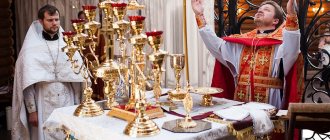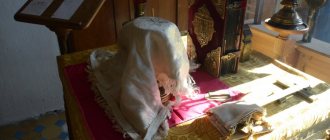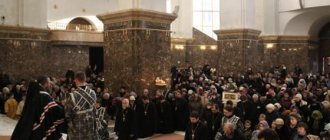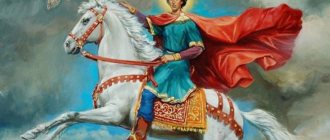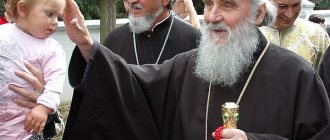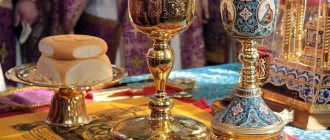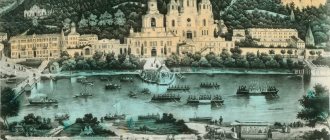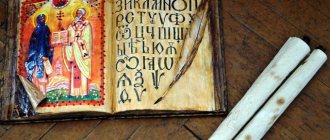About the Divine Liturgy for children
"Liturgy" is a Greek word. In Ancient Greece, certain common tasks that were too much for one person to do were called “liturgies.” The first Christians called this word the main service of God.
Divine Liturgy is the most important church service
The Liturgy remembers the earthly life of Jesus Christ from birth to His ascension to Heaven, His teaching and the saving benefits He brought to earth. The order of the Liturgy is as follows: first, everything necessary for the Sacrament of Communion is prepared; then the believers prepare for the Sacrament; and finally, the Sacrament itself is performed, and the believers receive communion.
The liturgy is thus divided into three parts:
Proskomedia
“Proskomedia” is a Greek word and means “offering.” The name of the first part of the Liturgy is associated with the custom of ancient Christians to bring bread, wine and everything necessary for the celebration of the Liturgy. Therefore, the bread eaten on it is called prosphora.
, which means "offering". We cannot live without food and drink. Therefore, our gifts mean that we offer our lives as a gift to God.
During Proskomedia, the priest prepares our gifts (prosphora). For Proskomedia, five service prosphoras are used (in memory of how Jesus Christ fed more than five thousand people with five loaves of bread) as well as prosphoras ordered by parishioners. For communion, one prosphora (Lamb) is used, which in size must correspond to the number of communicants. The priest takes out a particle from each prosphora and places them on the paten (golden plate) in strict order:
the “Lamb” ) is placed in the center
- the priest places a particle from the second prosphora, called “Theotokos” (in honor of the Mother of God), on the right side of the “Lamb”;
- particles from the nine-tier prosphora (in honor of all saints) - on the left side of the “Lamb” (three particles in a row);
— particles for the living are placed below the “Lamb”;
- particles for the deceased - even lower;
— particles from the prosphoras served by believers are placed together with particles taken from the fourth and fifth prosphoras.
The combination of all particles on the paten in this order means the entire Church of God
.
Jesus Christ
Himself .
Proskomedia is performed by the priest in a low voice on the Altar with the Altar closed. At this time, the third and sixth hours according to the Book of Hours (the liturgical book) are read.
Catechesis (Sunday school for adults)
On October 28, 2021, on Dimitrievskaya Parent Saturday, the abbot of the St. Nicholas Monastery in the city of Gomel, Archimandrite Ambrose (Shevtsov), celebrated the children’s Divine Liturgy in the gateway church of St. Dionysius of Radonezh.
During the unusual service, chants were performed by a folk choir of children and their parents. The choir was directed by Archimandrite Savva (Mazhuko). Before Communion, Father Savva preached a sermon (
).
Hegumen Theodorit (Zolotarev) confessed to the little parishioners and students of the monastery Sunday school.
After the service, the communicants gathered in the school auditorium for a friendly tea party with sweets.
From an interview with Archimandrite Savva (Mazhuko) on the website of the Synodal Department for Monastic Affairs and Monasticism of the Belarusian Exarchate of the Moscow Patriarchate (full version of the interview):
– How are children’s liturgies going?
– We serve children’s liturgy monthly in the gate church. We invite only families with children there. We do not focus on children. I formulated the concept of working with children this way: we work with the family, not with the children. We focus specifically on family. And first of all, we help them become church members, and not give them some knowledge, which is generally quite difficult to do when communicating an hour a week. We had ideas, for example, to introduce more subjects, and, by the way, there are opportunities for this. But getting the kids together is not easy. Some people go in for swimming, some people play music, some people have to travel far, and so they only last an hour a week, no more, while others come once a month – that’s how it turns out. But everyone comes to the children’s liturgy with pleasure, although it starts at 7 in the morning - we simply cannot do otherwise, because then they baptize in the church. Children's liturgy is always on Saturdays. The whole family usually comes. This liturgy is usually performed by our vicar, Father Ambrose. Serves with the Royal Doors open, as on Easter. I’ll say right away: this liturgy is slightly shortened, and we made these changes consciously and carefully, guided by the very logic of the service. Therefore, our children's liturgy has its own characteristics.
We read the third hour with a prayer from the sixth hour. Usually we entrust this reading to one of the parents. I have an idea, but we haven't done it yet: break up this third hour into chunks and give the kids each a piece to read. Another thing is that we begin to confess on the clock, which introduces certain difficulties. An important feature: the liturgy is sung by all those present. We have special books, we have selected a repertoire. Since I am the “old” regent, this is my element, I selected the chants myself. But everyone sings, they’ve already gotten used to it. Maybe not always slender, but everyone likes it. Even the little ones who can’t read pick up the books with an important look, and everyone participates. They stand at the church with books in their hands, sing, pray, confess, and light candles. Children serve at the altar. We bought a censer in Moscow (this is a censer for the laity, not on a chain, like a deacon’s, but with a handle), and there is an idea for boys to use the censer on the clock. Not the priest, but the children themselves. This invigorates them very much, because it is a high responsibility. We want them to go to religious processions with these katsiyas. We have noticed that being involved in worship is important even for adult parishioners. We have sewn many banners and instruct our pilgrims to wear them on holidays. This is a very important event for men at religious processions. On the Assumption we make a big religious procession around our entire neighborhood, and for everyone this is the most important, truly “common cause.” We also want to sew children's banners. Our girls mostly either read or sing, and the boys come to serve. But I digress. So we sing the liturgy. We read the Apostle and the Gospel only in Russian. The Apostle is read by one of the children, and the Gospel is read by a priest. After the Gospel there is a special litany, and we immediately sing the Cherubic Litany. There is no litany of petition after the Cherubic litany, we omit it, but the priest says the exclamation “By the generosity of the Only Begotten...”, and Father Ambrose turns and says to everyone present: “Christ is in our midst.” They answer him: “And it is and it will be.” This is a very exciting moment for pilgrims. Then we sing “I Believe...”, then the Eucharistic Canon. We skip the petitionary litany after the Eucharistic canon, and immediately “Our Father.”
During the priest's communion at the altar, I speak the sermon. I either talk about some chant that we sang, or I analyze the Gospel reading. For example: we just sang “Cherubimskaya”. What does this chant mean? Or I show an image of the Eucharist on the iconostasis and explain what it means. That is, we combine liturgy with a lesson. And this, you know, is very lively, relaxed, homely.
Liturgy of the Catechumens
During the Liturgy of the Catechumens (the catechumens are those preparing to receive Holy Baptism), we learn how to live according to the Commandments of God. It begins with the Great Litany, in which the priest or deacon reads short prayers about times of peace, about health, about our country, about our loved ones, about the Church, about the Patriarch, about those traveling, about those in prison or in trouble. After each petition, the choir sings: “Lord have mercy.”
After the Great Litany, the First Antiphon (Psalm 102) is sung : “Bless the Lord, my soul...” . After the Lesser Litany, the Second Antiphon (psalm 145) is sung : “Praise, my soul, the Lord...”. These psalms are called antiphons - they are supposed to be sung on two choirs alternately.
At the end of the Second Antiphon, “The Only Begotten Son...” . This hymn sets out the Orthodox teaching about the Second Person of the Holy Trinity - the Son of God Jesus Christ.
This is followed by the Small Litany and the singing of the third antiphon - “The Beatitudes of the Gospel” (the rules of life that the Lord Jesus Christ gave us). When the Third Antiphon is sung, the Royal Doors
.
At the end of the Beatitudes, the priest solemnly carries out the Gospel
and just as solemnly brings it into the Altar through
the Royal Doors
.
(The procession of the clergyman with the Gospel is called the small entrance and reminds believers of the first appearance of Jesus Christ to preach). The singers sing the entrance: “Come, let us worship...” .
After this, troparia, kontakia and the Trisagion (Holy God...) are sung.
At the end of the Trisagion, a reader comes out to the middle of the church and reads the Apostle (an excerpt from the letters of the apostles to the first Christians).
After reading the “Apostle,” the deacon or the priest himself reads the Gospel
.
After reading the Gospel
followed by a special (intensified) litany for the living and then a special litany for the dead.
After this, the catechumens are asked to leave the temple.
Liturgy Map
New publishing project of the official radio station of the St. Petersburg Metropolitanate “Grad Petrov”: “Journey to the Heavenly City of Jerusalem.” Educational program for the study of Liturgy for children 10-14 years old. Set: book, map, audio CD
Olga Antipova “Journey to the Heavenly City of Jerusalem”
Educational program for studying the Liturgy for children 10-14 years old
This course was developed and tested at the Sunday school of the Church of St. Anastasia the Pattern Maker on Vasilyevsky Island, headed by Olga Antipova. The purpose of the course is to introduce children to the main Sacrament of the Church, talk about the procedure for performing the service, the history of its formation, and the most important Christian symbols. To help you better understand and love the Liturgy.
How to do this so that children understand and find these lessons interesting? For this purpose, two manuals were developed: a book and a map.
First, a map of the Liturgy
- in fact, a detailed figurative diagram of the service, allowing you to see the most important system connections, clearly explain many things, and monitor the progress of the service. This is a map of the country along which the Church travels to Heavenly Jerusalem - to the Kingdom of God.
Secondly, the book “The Divine Liturgy with Illustrations and Explanations for Children”
. It contains the rites of the Liturgy with translations of obscure words and expressions, brief comments and, most importantly, with a large number of illustrations. After all, everyone loves picture books! These illustrations are masterpieces of world Christian art. Icons, frescoes, mosaics, book miniatures and stone carvings - these creations of great masters reveal to us the deep meaning of the corresponding moments of the service.
The course is complemented by two audio CDs containing 27 Sunday school lessons with a detailed analysis of the book and map
. A recording was made especially for these discs by the children's and youth church choir at the Ioannovsky Monastery (regent - Ksenia Kirillovna Golovkina). The choir performs the chants of the Liturgy, which are described on the discs. We think it is important that children taking the course hear not professional singers, but children like themselves.
HOW TO USE THE GUIDE
- adults can listen to the discs with a book in their hands and a map in front of their eyes, and then take the book to the service, follow its progress and remember everything that they heard on the discs;
- Sunday school teachers also listen to the course, so that they can then create appropriate lessons on their own (Attention! Children who are at least 10 years old and who already have some training can start studying the course!);
- the map of the Liturgy, with the blessing of the rector, can be in the church during the service, which will help children - with the help of the teacher - to follow its progress;
— parents can listen to the course on their own and then explain it to their children, or listen and understand everything TOGETHER with their children.
In other words, it is naive to think that you will sit your child in front of a tape recorder, give him a book and a map, lock him in the room, and after 12 hours you will have an expert and lover of the Liturgy.
More detailed recommendations will be available at seminars that will take place immediately after the publication of the manual.
HOW TO GET A BENEFIT
You can receive benefits in two ways:
1) take part in the subscription to the publication of the course at a discounted price of 550 rubles (book with color illustrations, map, 2 discs);
2) buy the manual after it is published.
The circulation is planned to be released by Easter 2013.
HOW TO TAKE PART IN THE SUBSCRIPTION
You can subscribe to the publication and make a prepayment
1) on weekdays
, from 11 to 18 o’clock, in the office of the radio “Grad Petrov” (St. Petersburg, Lieutenant Shmidta embankment, 39), phone: (812) 328-29-32;
2) on Saturdays and Sundays
, before and after the service, in the Church of St. Anastasia the Pattern Maker (at the same address).
We thank everyone involved in this project!
See also:
| Photo report from the annual Christmas fair of the radio “Grad Petrov”, which took place on December 22, 2012. Thanks to everyone who came! >> |
| CHILDREN “... I have many pleasant and dear memories of those animal babies to whom I gave a lot of warmth, love and care. And I really want you to get to know my students and fall in love with them...” From October 29 on our air - “Funny Animals” by Vera Chaplina >> |
| FOR CHILDREN: from October 17 on our air there is a series of programs based on the pages of the book by the Hungarian children’s writer Agnes Balint “Gnome Gnomych and Raisin” >> |
| VIDEO: its author Olga Antipova talks about the audio disc “What God’s World Sounds Like” >> |
| Olga Antipova. IN MEMORY OF ALEXEY ZAITSEV >> |
| Listen May 12, 2011 “Parents meeting.” Yuri Ivanov, Olga Antipova, Vladimir Knyazhitsky. Do schools perform an educational function? |
| Read “Let’s go to Narnia every year!” The program “Our Guest” is about how children from one St. Petersburg Sunday school visited a magical land. “Nowadays you can’t really go out with a sword - how can the Narnian spirit of chivalry live among us all and our children? But there is a feat of labor, a feat of patience, and a host of other feats that are not yet very interesting to our children, but which Narnia and its heroes help somehow connect with the idea of a feat - not just a boring duty, but a feat...” Program “We have guests" about how children from one St. Petersburg Sunday school visited the magical land of Clive Lewis. |
| Listen to Olga Antipova’s children’s program “What God’s World Sounds Like.” Lukomorye. Sound engineering work - Alexey Zaitsev. |
| Dad, mom, grandma, eight kids and a truck | Posidelkino. Tales of the peoples of the world. Issue 4. Italian fairy tales | FOOTPRINTS IN THE SNOW |
| mp3/1CD//100 rub. | MP3/1CD/07:10/90r | mp3/1CD/7:16/130r |
| What does God's world sound like? | F. Burnett. Little Lord Fauntleroy. Magic garden | A. Annenskaya. Brother and sister |
| mp3/1CD/6:18/100 rub. | CD/MP3/2CD/14:24/200rub | CD/MP3/1CD/3:21/100r |
| V.Gauf. Cold heart | E. Porter. Pollyanna | P. Gallico. Thomasina |
| CD/MP3/1CD/2:46/90 rub. | CD/MP3/1CD/6:50/90r | CD/MP3/1CD/14:54/90r |
| The Gospel retold for children | Daniel Defoe "Robinson Crusoe" | Astrid Lindgren We are all from Bullerby |
| CD/MP3/1CD/5:37/90 rub. | CD/MP3/1CD/7:56/100r | MP3/1CD/2:48/90r |
Liturgy of the Faithful
The third part is called the Liturgy of the Faithful
because only the faithful can attend it, i.e.
baptized. After inviting the catechumens to leave the temple, the Cherubic Hymn is sung. This song invites believers to abandon all thoughts of worldly things, to imagine that they, like the Cherubim, are near God, in Heaven, and, as if together with them, are singing the Trisagion to Him. After fulfilling the words: “Now let us put aside every care of this life...” the priest solemnly carries out the Holy Gifts
- bread and wine - from the northern gates of the Altar.
Stopping at the Royal Doors
, he prays for everyone whom we especially remember, and, returning through
the Royal Doors
to the Altar, places
the Honest Gifts
on the Throne.
(The transfer of gifts from the Altar to the Throne is called the Great Entrance and marks the solemn procession of Jesus Christ to free suffering and death on the cross). The choir continues to sing “Cherubimskaya” with the words: “For let us raise all the Tsar...” .
After the “Cherubimskaya” the litany of petition is heard and one of the main prayers is sung -
Text of the book “Children about Orthodoxy. About liturgy"
Vladimir Luchaninov Children about Orthodoxy. About liturgy
Artist
Anastasia Novik
See with your heart
You are going to the temple. Or rather, your parents woke you up and are getting you ready, still quite sleepy. You are going to the liturgy. And most people sleep on Sunday until they can sleep. But you know, a couple of extra hours spent in bed will not bring happiness. And very soon you will find yourself in an amazing world where miracles happen. The most real thing. Have you dreamed about this? At the Liturgy, you can safely ask Jesus Christ for everything. Just don't doubt it. Liturgy is the best time for a miracle.
“But there are so many adults in the temple that only their legs and backs are visible. How can you ask if Christ is not even visible? And if it is visible, it is on the icon. But you can’t really talk with an icon, like you can with the same people in the temple.”
Let's figure it out, your question is very important. You can see with your eyes - it’s not at all difficult, especially if your vision is good. But they also see with their hearts - and this is already learned.
How do they learn, for example, to draw? Diligence. The more we draw, the more beautiful it turns out. It’s the same with the ability to see with the heart. We already have the ability within us, we just need to extract it. It is embedded within us. Sometimes you learn this all your life. But it’s not at all bad to study all your life. It’s like going to a holiday: the road itself is joyful, because you are not going somewhere, but to a holiday.
The temple is called the House of God on earth.
Lamps burn in front of the icons, people light candles and whisper about their needs. Icons are wonderful images. Looking at the faces of God, the Mother of God, angels and saints, we talk to them and gradually begin to see and hear them with our hearts.
Conversation with God
People, behind whose backs nothing is visible, come to church on Sunday to see God in their hearts and talk to Him. A conversation with God is called prayer. Now you don’t understand the prayers that are sung in the temple, but over time you will definitely understand. Listen, ask adults, but most importantly, start talking to God yourself, in the simplest words.
It is important to learn to understand God's answers. You won't hear them with your ears. The answers will come through people, through unexpected events, through miracles. Learn not only to see, but also to hear with your heart. And may all your wishes be good!
Prayer in your own words
“Lord, I believe and know that You hear me. You see, mom and dad don’t want to have a kitten, but I really want to. Please make sure that we have a kitten and that dad and mom will also be happy about it and that it won’t be difficult for anyone!”
It is with good desires that people come to the liturgy to its good host Jesus Christ. Saints and people who lived hundreds and thousands of years before us come with us. Because those who see Jesus Christ in their hearts never die, their souls live in eternal joy in the Kingdom of God.
About the temple
“Temple” is an ancient Slavic word, its meaning is “house”. A special House, sacred, connecting earth and heaven, time and eternity, God and man. The house of our Heavenly Father and ours. Here we gather in His Name. And where people gather in the Name of the Lord, He will always be with them.
Common cause
At liturgy we gather to thank God for life. You think, laugh, see the beauty of God's world, feel your favorite tastes and smells, run and frolic, learn something new every day. How great is this!
Thanksgiving
Together we stand in the temple, because the liturgy is a common cause, translated from Greek. They also call it the word “Eucharist” (you don’t have to remember it yet). Eucharist in Russian means “thanksgiving.” But this word is very important to remember!
It happens that people get used to life and become boring. “Well, what’s special here,” they think, “I live for myself and live.” Only after an illness, having felt relief, can they still remember how little is needed for happiness - just to feel good: breathe, eat with appetite, smile, make friends, read your favorite books.
An ungrateful person does not see a miracle, because he is always lacking something, he is always greedily looking for something more, in addition to what he already has.
But a grateful person appreciates what he has and sees the benefit given to him. Such people gather for the liturgy to say “thank you” to God for their lives. After all, life itself is a real miracle!
Thank God
. Do not hesitate to ask Him and even beg. There are no small things for Him, He is attentive, generous and loves to do good.
God loves us
God often gave people rules for eternal life. People did not always follow these rules. The world exists according to its own laws. There are visible laws: if you touch fire, you will definitely burn your hand. And there are invisible ones - an evil deed certainly burns the soul. You don't feel it right away. But each time the burn increases, and over time the soul becomes incapable of good. It darkens, becomes stale, charred and loses eternal life.
He who eats My Flesh and drinks My Blood has eternal life, and I will raise him up on the last day.
For My Flesh is truly food, and My Blood is truly drink. He who eats My Flesh and drinks My Blood abides in Me, and I in him. Gospel of John, chapter 6, verses 53–56
To save us from destruction, God became a man and came into the world. The Divine Holy Spirit overshadowed the kindest of all earthly girls - Mary (later she was called the Mother of God), she miraculously gave birth to Jesus Christ - the Son of God.
Jesus walked the earth, preached, healed people, and raised the dead. But envious people with dark, charred hearts could not bear the light that emanated from Him. Jesus was slandered and sentenced to death.
About the Mother of God
Pay attention to how many images in the temple of the Virgin Mary holding Her Son, the Infant Christ, in her arms. We glorify Her, call Her the Mother of God and Mother of God, we pray to Her, and She will always hear us, console us and support us.
The night before his arrest, the Lord Jesus Christ, knowing that He would soon be captured, took bread in his hands. Having broken it and given it to the disciples, he said: “This is My body, which is being given over to suffer for you. Always do this in remembrance of Me!”
Then He took a cup of wine. “This cup is the New Covenant in My blood, which is shed for you!” - Christ said, passing the cup to the disciples.
This is how the first liturgy took place - it is called the Last Supper.
Jesus was killed. Crucified on the cross. But He is the God-man, death could not take Him, three days later Christ rose from the dead. The day of His resurrection changed the whole world. The path to the Kingdom of Heaven was opened for people. This day was called Sunday, which is why every Sunday we gather for liturgy.
For two thousand years now
By a miracle of God, the bread and wine brought to the Liturgy become the Body and Blood of Jesus Christ. In appearance, the Holy Gifts remain wine and bread, but when we eat them, we unite with the Risen Christ, He enters our heart, and we become immortal.
Altar
Preparation
The liturgy begins with preparation. Everything necessary is brought to the altar. First of all, bread and wine. The wine must be natural - grape, and the bread - wheat, fresh and tasty. Bread for the liturgy is baked at the church, and it is called prosphora, which means “offering.”
In ancient times, people baked bread themselves and brought it to the temple and brought their own homemade wine. They sacrificed the best they had. The offerings were placed on a special table - an altar. For the liturgy, the clergy chose the best of what was brought, and what was left after the service, with blessing and prayer, was served at a common feast, where the poor, who had nothing of their own, were necessarily invited.
Altar
This is the most important place. Only clergy and those who help them come here. The altar is hidden behind the iconostasis. In the center of the altar is the Holy See. It is on the throne that the main miracle of the world takes place - bread and wine become the Body and Blood of Jesus Christ.
Entering the altar, the priest asks God for blessing to serve the liturgy. He then prays while wearing sacred vestments. Liturgy is, first of all, joy, and sacred vestments are the clothing of joy and righteousness in the Kingdom of God.
The priest takes the bread and, prayerfully remembering the suffering of Christ, places a large prosphora on a special round tray - paten. The priest pours the wine into a beautiful cup - a chalice. When Jesus suffered on the cross
…
end of introductory fragment
